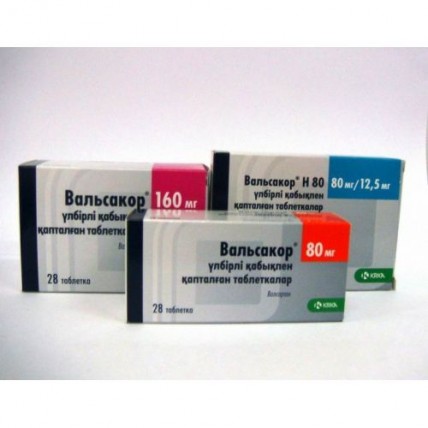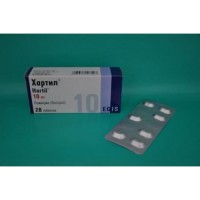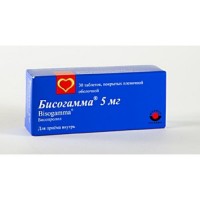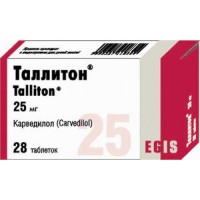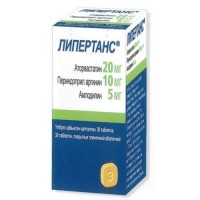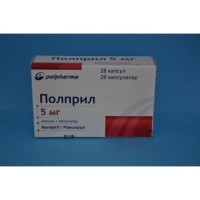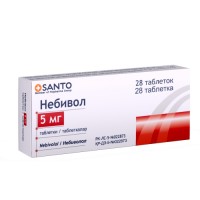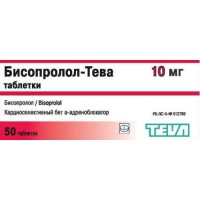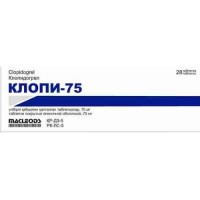H Valsakor® 80 mg / 12.5 mg 28's film-coated tablets
- $29.70
Sku:
b5a85b5de5be
Brand:
KRKA (Slovenia)
The instruction for medical use
of Valsakor medicine ® N 80,
Valsakor ® N 160,
Valsakor ® ND 160
the Trade name
Valsakor ® N 80,
Valsakor ® N 160,
Valsakor ® ND 160
the International unlicensed name
Is not present
the Dosage form
of the Tablet, film coated 80 mg / 12.5 mg, 160 mg / 12.5 mg and 160 mg / 25 mg
Structure
One tablet supports
Valsakor ® N the 80th
active agents: valsartan 80 mg, hydrochlorothiazide of 12.5 mg,
Valsakor ® N the 160th
active agents: valsartan 160 mg, hydrochlorothiazide of 12.5 mg
Valsakor ® ND 160
active agents: valsartan 160 mg, hydrochlorothiazide of 25 mg
excipients: microcrystalline cellulose, lactoses monohydrate, magnesium stearate, sodium of a kroskarmelloz, K 25 povidone, silicon dioxide colloidal anhydrous
film cover: a gipromelloza 2910, the titan dioxide (E171), a macrogoal 4000, ferrous oxide red (E172), ferrous oxide yellow (E172) (for dosages of 80 mg / 12.5 mg and 160 mg / 25 mg)
the Description
of the Tablet of an oval form, film coated pink color, biconvex (for a dosage of 80 mg / 12.5 mg).
Tablets of an oval form, film coated red-brown color, biconvex (for a dosage of 160 mg / 12.5 mg).
Tablets of an oval form, film coated light brown color, biconvex (for a dosage of 160 mg / 25 mg)
Pharmacotherapeutic group
the Drugs influencing a system renin-angiotensin. Angiotensin II antagonists in a combination with other drugs. Angiotensin II antagonists in a combination with diuretics. Valsartan in a combination with diuretics.
ATH C09 DA03 code
the Pharmacological
Pharmacokinetics Valsartan properties Absorption of a Valsartan happens quickly, however extent of absorption varies over a wide range. The average size of bioavailability is 23%. The pharmacokinetic curve valsartana has the descending multiexponential character (t1/2a & lt, 1 h and t1/2b about 9 h).
The kinetics of a valsartan has linear character. At repeated use of drug of changes of kinetic indicators it is not noted. At administration of drug once a day cumulation insignificant.
Valsartan for 94-97% contacts serum proteins, mainly albumine. Equilibrium volume of distribution low (about 17 l). In comparison with a hepatic blood-groove (about 30 l/hour), the plasma clearance of a valsartan occurs rather slowly (about 2 l/hour). Removal of a valsartan with a stake makes 83% (from the size of the dose accepted inside). With urine about 13%, mainly in not changed look are removed.
When assigning a valsartan with food the area under a curve concentration time (AUC) decreases by 48% though, since about the 8th hour after administration of drug of concentration of a valsartan in plasma both in case of its reception on an empty stomach, and in case of reception with food, identical. Reduction of the area under a curve concentration time is not followed by clinically significant decrease in therapeutic effect.
The hydrochlorothiazide
Absorption of a hydrochlorothiazide occurs quickly (tmax-is about 2 hours old). Elimination half-life of a final phase makes 6-15 hours.
The average size AUC increases in the therapeutic range of doses in direct ratio to increase in a dose. At repeated appointments the pharmacokinetics of a hydrochlorothiazide does not change, when assigning once a day cumulation is insignificant.
The bioavailability of a hydrochlorothiazide is 70%. Removal happens to urine: more than 95% of a dose in not changed look and about 4% - in the form of a hydrolyzate - 2-amino-4-chloro-m-benzenedisulfonamida.
Valsartan / a hydrochlorothiazide
At combined use with valsartany the system bioavailability of a hydrochlorothiazide decreases approximately by 30%. Co-administration of a hydrochlorothiazide, in return, has no significant effect on kinetics of a valsartan. Noted interaction does not influence efficiency of the combined use of a valsartan and a hydrochlorothiazide. The distinct antihypertensive effect of this combination which exceeds effect of each of components separately is revealed.
The pharmacokinetics at separate groups of patients
Patients of advanced age
At elderly patients (both healthy, and having an arterial hypertension) system clearance of a hydrochlorothiazide is lower, than at young people.
Patients with a renal failure
Sick with clearance of creatinine of 30-70 ml/min. of dose adjustment it is not required.
Now patients have no data on use of a combination of the fixed doses valsartan / a hydrochlorothiazide with the profound renal failures (clearance of creatinine less than 30 ml/min.) and at the patients who are on a hemodialysis.
A pharmacodynamics
the Combination of the fixed doses valsartan / a hydrochlorothiazide – antihypertensive drug which part are the antagonist of receptors of angiotensin II and thiazide diuretic.
The system renin-angiotensin-aldosteronovoy (SRAA) is active hormone angiotensin II which is formed of angiotensin I with the participation of APF. Angiotensin II contacts the specific receptors located on cellular membranes in various fabrics. It has a wide range of the physiological effects including first of all both the direct, and mediated participation in regulation of arterial blood pressure. Being powerful vasoconstrictive substance, angiotensin II causes the direct pressor answer. Besides, it stimulates secretion of Aldosteronum and promotes a sodium delay.
Valsartan - the active and specific antagonist of receptors of angiotensin II intended for intake. It affects selectively AT1 subtype receptors which are responsible for the known effects of angiotensin II. The increased serumal levels of angiotensin II owing to blockade of AT1 of receptors valsartany can stimulate free AT2 - receptors that counterbalances effect of AT1-receptors. valsartan does not show any significant agonistic activity concerning AT1 subtype receptors. The affinity of a valsartan to receptors of AT1 subtype is about 20,000 times higher, than to AT2 subtype receptors.
Valsartan does not inhibit APF known also under the name of a kininaza II which turns angiotensin I into angiotensin II and destroys bradykinin. Any side effects caused by bradykinin are not observed. Frequency of development of dry cough is lower at the patients receiving valsartan than at the patients receiving APF inhibitor. Valsartan does not enter interaction and does not block the receptors of other hormones or ion channels which are important for regulation of functions of a cardiovascular system.
At treatment valsartany patients with an arterial hypertension the lowering of arterial pressure which is not followed by change of pulse rate is noted.
After appointment in a single dose of drug at most of patients the beginning of antihypertensive action is noted within 2 hours, and the maximum lowering of arterial pressure (ABP) is reached within 4-6 hours. After administration of drug the antihypertensive action remains more than 24 hours. At repeated prescribing of drug the maximum decrease in the ABP, regardless of the accepted dose, is usually reached within 2-4 weeks and supported at the reached level during long therapy. At combination with a hydrochlorothiazide the reliable additional decrease in the ABP is reached.
A point of application of effect of thiazide diuretics is the cortical department of distal wavy renal tubules where receptors, highly sensitive to effect of diuretics, and where there is a suppression of transport of ions of Na and Cl are located. The mechanism of action of tiazid is connected with suppression of the pump Na+Cl-that, apparently, occurs due to the competition for places of Cl-transport. As a result of it excretion of ions of sodium and chlorine increases approximately to the same extent. As a result of diuretic action the reduction of volume of the circulating plasma is observed owing to what the activity of renin, secretion of Aldosteronum, removal with urine of potassium and, therefore, decrease in potassium concentration in serum increases. The interrelation between renin and Aldosteronum is mediated by angiotensin II therefore appointment of the antagonist of receptors of angiotensin II will reduce the potassium losses connected with use of thiazide diuretic.
Valsartan has high extent of linking with proteins of plasma and is not brought at a hemodialysis. The hydrochlorothiazide, on the contrary, is brought out of an organism at a hemodialysis.
Removal of a hydrochlorothiazide kidneys happens by passive filtration and active secretion in a gleam of renal tubules. The condition of function of kidneys plays a large role in hydrochlorothiazide pharmacokinetics that is quite clear, considering that this drug is removed only by kidneys.
Patients with an abnormal liver function
System influence of a valsartan at patients with mild and moderate abnormal liver functions are twice more, than at healthy. There are no data on use of a valsartan for patients with heavy abnormal liver functions now.
Diseases of a liver have no significant effect on hydrochlorothiazide pharmacokinetics therefore decrease in its dose is not required.
Indications
- arterial hypertension
- treatment of patients with arterial hypertension at whom it is not possible to reach adequate control of arterial blood pressure at monotherapy by the drug Valsakor®
- treatment of the patients with arterial hypertension needing use of several drugs for achievement of target arterial blood pressure (as initial therapy). The choice of a combination of the fixed doses valsartan / a hydrochlorothiazide as drug of the first line, in this case, has to be based on assessment of advantage and risks.
A route of administration and doses
the Recommended drug Valsakor dose ® N 80 and Valsakor ® N 160 - on 1 tablet once a day daily. If necessary the dose can be increased up to 160 mg of a valsartan and 25 mg of a hydrochlorothiazide (1 tablet Valsakor ® by ND 160). The maximum antihypertensive effect is observed in the first 2-4 weeks of treatment.
With poorly or moderate renal failures (clearance of creatinine & gt, 30 ml/min.) of changes of a dose of drug it is not required to patients. Also it is not required to change a drug dose at patients with poorly or moderate liver failure of not biliary genesis, without cholestasia epiphenomena.
Safety and efficiency of use of drug of a combination of the fixed doses valsartan / a hydrochlorothiazide at children aged are younger than 18 years are not established.
Side effects
the Frequency of side effects at use of a combination of the fixed doses valsartan / a hydrochlorothiazide:
Infrequently (from & gt, 1/1000 to & lt, 1/100)
- dehydration
- paresthesia
- disorders of vision
- sonitus
- hypotension
- cough
- myalgia
- fatigue
Very seldom (& lt, 1/10000)
- dizziness
- diarrhea
- an arthralgia
With an unknown frequency
- a syncope
- not cardiogenic fluid lungs
- a renal failure
- increase in level of uric acid, bilirubin and creatinine in blood serum, a hypopotassemia, a hyponatremia, increase in level of urea nitrogen in blood, a neutropenia
the Following undesirable phenomena were also observed during clinical trials at patients with hypertensia, irrespective of their communication with administration of drug: abdominal pain, pain in an upper part of a stomach, concern, arthritis, an asthenia, a dorsodynia, bronchitis, an acute bronchitis, a stethalgia, postural dizziness, dyspepsia, dispnoe, dryness in a mouth, nasal bleeding, erectile dysfunction, a gastroenteritis, a headache, a hyperhidrosis, a hypesthesia, flu, insomnia, sprain, muscular spasms, a muscle strain, a slime accumulation in a nose, a nasopharyngitis, nausea, neck pain, hypostasis, peripheral hypostasis, otitis of a middle ear, extremity pain, a cardiopalmus, a sore throat, throats, a pollakiuria, a hyperthermia, sinusitis, drowsiness, tachycardia, upper respiratory tract infections, infections of urinary tract, vertigo, viral infections, disorders of vision.
Side effects about which it was reported at reception of one of drug components can be also observed at reception of a combination of the fixed doses valsartan / a hydrochlorothiazide
the Frequency of side effects at use of a valsartan
Infrequently (from & gt, 1/1000 to & lt, 1/100)
- vertigo
- abdominal pain
With an unknown frequency
- decrease in level of hemoglobin, a hematocrit, thrombocytopenia
- other reactions of hypersensitivity / allergic reactions, including a serum disease
- increase in level of potassium in blood
- a vasculitis
- a Quincke's disease, an itching, rash
- a renal failure
the Following undesirable phenomena were also observed during clinical trials at patients with hypertensia, irrespective of their communication with administration of drug: arthralgia, asthenia, dorsodynia, diarrhea, dizziness, headache, insomnia, decrease libido, nausea, hypostasis, pharyngitis, rhinitis, sinusitis, upper respiratory tract infections, viral infections.
Frequency of side effects at use of a hydrochlorothiazide
Very often (& gt, 1/10)
- increase in level of lipids in blood (generally at reception of high doses)
Is frequent (from & gt, 1/100 to & lt, 1/10)
- a hypomagnesiemia, a hyperuricemia
- a small tortoiseshell and other forms of rash
- a loss of appetite, moderate nausea and vomiting
- orthostatic hypotension which can amplify under the influence of alcohol, anesthetics or sedatives
- impotence
Seldom (from & gt, 1/10000 up to 1/1000)
- a hypercalcemia, a hyperglycemia, a glucosuria and deterioration in the diabetic metabolic status
- reaction of photosensitivity
- abdominal discomfort, a constipation, diarrhea
- a cholestasia or jaundice
- arrhythmia
- a headache, dizziness, sleep disorders, a depression and paresthesia
- disorders of vision, especially in the first several weeks of treatment
- thrombocytopenia sometimes with a purpura
Very seldom (& lt, 1/10000)
- a gipokhloremichesky alkalosis
- the necrotizing vasculitis and a toxic epidermal necrolysis, skin reactions reminding a system lupus erythematosus, aggravation of skin manifestations of a system lupus erythematosus
- pancreatitis
- a leukopenia, an agranulocytosis, dysfunctions of marrow, hemolytic anemia
- reactions of hypersensitivity – a respiratory distress a syndrome, including pneumonia and a fluid lungs
With an unknown frequency
- a multiformny erythema
- acute closed-angle glaucoma
- aplastic anemia
- an acute renal failure, a renal failure
- a hyperthermia, an asthenia, muscular spasms
of the Contraindication
- hypersensitivity to a valsartan, a hydrochlorothiazide, other sulfonamides or to other Valsakor excipients ® N 80, Valsakor ® N 160 and Valsakor ® ND 160
- pregnancy and the period of a lactation
- heavy abnormal liver functions, biliary cirrhosis and a cholestasia
- an anury, heavy renal failures (clearance of creatinine & lt, 30 ml/min.)
- simultaneous use of antagonists of receptors of angiotensin, including valsartan, or APF inhibitors with aliskireny at patients with diabetes 2 types
the Medicinal interactions
Connected with valsartany
Double blockade the system renin-angiotenzinovoy (SRA) inhibitors of receptors of angiotensin, APF inhibitors or aliskireny
Simultaneous use of inhibitors of receptors of angiotensin including valsartan, with other drugs operating on SRA are connected with increase in frequency of hypotension, a hyperpotassemia, and change of function of kidneys in comparison with monotherapy. Control of arterial blood pressure, function of kidneys and electrolytes at the patients accepting valsartan and other drugs which influence SRA is recommended.
Potassium
Simultaneous use of salts of potassium, kaliysberegayushchy diuretics, kaliysoderzhashchy substitutes of edible salt or any other medicines which can cause increase in potassium concentration in blood (for example, heparin) demands observance of precautionary measures and, in particular, frequent definition of potassium concentration in blood.
Non-steroidal anti-inflammatory drugs (NPVP), including selection TsOG-2 inhibitors
At simultaneous use of antagonists of angiotensin II with NPVP there can be an easing of antihypertensive effect. Besides, simultaneous use of antagonists of angiotensin II and NPVP can result in the increased risk of deterioration in function of kidneys and level of potassium in blood serum. Therefore in an initiation of treatment the control of function of kidneys and also the corresponding hydration of the patient is recommended.
Conveyors
Results of the research in vitro of tissue of liver of the person demonstrate to what valsartan is substrate of the conveyor of hepatic capture OATP1B1 and substrate of the conveyor of hepatic outflow of MRP2. Co-administration of inhibitors of the conveyor of capture (rifampicin, cyclosporine) or the outflow conveyor (ritonavir) can increase system influence of a valsartan.
Other drugs
In researches of interaction of medicines with valsartany clinically significant interactions of a valsartan with any of the following substances were not observed: Cimetidinum, warfarin, furosemide, digoxin, atenolol, indometacin, hydrochlorothiazide, amlodipin, glibenclamide.
Connected with a hydrochlorothiazide
of Lities
At co-administration of drugs of lithium with APF inhibitors, antagonists of receptors of angiotensin II or thiazide diuretics noted reversible increase in concentration of lithium in serum and strengthening, in this regard, of toxic manifestations. As the renal clearance of lithium decreases tiazidam, the risk of toxicity of lithium presumably can be increased at further use of a combination of the fixed doses valsartan / a hydrochlorothiazide. Thus, careful monitoring of concentration of lithium in blood serum is recommended during simultaneous use.
Other antihypertensive drugs
strengthening of antihypertensive effect at combined use with other antihypertensive drugs is possible (guanitidin, Methyldopum, beta-blockers, vasodilators, blockers of calcium channels, APF inhibitors, blockers of angiotenzinovy receptors and direct inhibitors of renin).
Muscular relaxants
of Tiazida exponentiate action of kurarepodobny muscle relaxants.
The drugs influencing potassium level in blood
Risk of development of a hypopotassemia raises at co-administration of saluretics, corticosteroids, adenokortikotropny hormone (AKTG), Amphotericinum, a karbenoksolon, penicillin G and derivatives of salicylic acid.
The drugs influencing sodium level in blood
Giponatriyemichesky effect of diuretics can amplify at simultaneous use of antidepressants, anti-psychotics, anti-epileptic means, etc. It is necessary to be careful at prolonged use of these drugs.
Anti-diabetic agents
of Tiazida can change tolerance to glucose. Dose adjustment of insulin or oral glucose-lowering drug can be required.
Thiazide diuretics such undesirable effects as a hypopotassemia or a hypomagnesiemia which, in turn, increase risk of developing arrhythmia in glikozidny intoxication can cause foxglove glycosides.
NPVS and selection TsOG-2 inhibitors
is possible reduction of diuretic and antihypertensive action of a thiazide component of a combination of the fixed doses valsartan / a hydrochlorothiazide at simultaneous use with non-steroidal anti-inflammatory drugs (NPVS) (for example, with derivatives of salicylic acid, indometacin). The accompanying hypovolemia can lead to development of an acute renal failure.
Co-administration of thiazide diuretics can lead to the following phenomena: to increase the frequency of reactions of hypersensitivity to Allopyrinolum, to increase risk of development of side effects of an amantadin, to strengthen hyper glycemic effect of diazoxide, to reduce removal by kidneys of cytotoxic drugs (for example, cyclophosphamide, a methotrexate) and to lead to potentiation of their myelosuppressive action.
Increase in bioavailability of thiazide diuretic is observed at co-administration of holinoblokator (for example, atropine, Biperidinum) that, apparently, it is connected with decrease in physical activity of digestive tract and delay of gastric emptying. Tsizaprid can reduce bioavailability of thiazide diuretics.
Holestiramin or kolestipol reduce absorption of thiazide diuretics. However use of a hydrochlorothiazide in 4 hours prior to or 4-6 hours after intake of these drugs can potentially minimize this interaction.
Vitamin D
At combined use of thiazide diuretics with vitamin D or salts of calcium the potentiation of increase in concentration of calcium in serum is possible.
Cyclosporine
Co-administration of cyclosporine can increase risk of development of a hyperuricemia and emergence of the symptoms reminding exacerbation of gout.
Simultaneous use of thiazide diuretics can lead calcium salts to a hypercalcemia, increasing a calcium reabsorption in tubular bones.
Methyldopum
It was reported about cases of development of hemolytic anemia at
co-administration of thiazide diuretic and Methyldopums.
Alcohol, barbiturates or drugs
Simultaneous use of thiazide diuretics with alcohol, barbiturates or drugs can exponentiate orthostatic hypotension.
Special indications
of Change of balance of electrolytes of serum
It is necessary to be careful at simultaneous use of a combination of the fixed doses valsartan / a hydrochlorothiazide with potassium salts, kaliysberegayushchy diuretics, kaliysoderzhashchy substitutes of edible salt and also with medicines which can cause increase in potassium concentration in blood (for example, heparin).
There are messages about development of a hypopotassemia at treatment by thiazide diuretics. Frequent control of potassium concentration in blood is recommended.
At use of thiazide diuretics the hyponatremia and a gipokhloremichesky alkalosis can develop. Tiazida cause increase in excretion with magnesium urine that can lead to a hypomagnesiemia.
The deficit in an organism of sodium and/or the volume of the circulating blood (VCB)
At patients with the significant deficit in the organism of sodium and/or OCK, for example, receiving high doses of diuretics in rare instances in an initiation of treatment with a combination of the fixed doses valsartan / a hydrochlorothiazide can arise arterial hypotension. Before an initiation of treatment it is necessary to carry out correction of content of sodium in an organism and/or the volume of the circulating blood, for example, by reduction of a dose of diuretic.
In case of development of hypotension of the patient it is necessary to lay and, if necessary, to carry out intravenous infusion of normal saline solution. After stabilization of arterial blood pressure treatment by a combination of the fixed doses valsartan / the hydrochlorothiazide can be continued.
A renal artery stenosis
Safety of use of a combination of the fixed doses valsartan / a hydrochlorothiazide at patients with a unilateral or bilateral renal artery stenosis or a stenosis of an artery of the only kidney is not established.
The renal failure
to Patients with a renal failure when the clearance of creatinine is more than 30 ml/min., is not required corrections of a dose of drug. The combination of the fixed doses valsartan / a hydrochlorothiazide has to be applied with care at patients with a heavy renal failure (clearance of creatinine & lt, 30 ml/min.) because of a hydrochlorothiazide. Thiazide diuretics can cause an azotemia in patients with a chronic disease of kidneys. They are inefficient as monotherapy in a heavy renal failure (clearance of creatinine & lt, 30 ml/min.), but can be useful when they are applied with care in a combination with loopback diuretics even at patients with clearance of creatinine & lt, 30 ml/min.
It is necessary to avoid simultaneous use of inhibitors of receptors of angiotensin, including valsartan, and APF inhibitors together with aliskireny at patients with a heavy renal failure (SKF & lt, 30 ml/min.).
The abnormal liver function
is not required changes of a dose from patients with poorly or moderate abnormal liver functions in the absence of the cholestasia phenomena though it is recommended to be careful.
A Quincke's disease
there Are messages about the Quincke's disease including edema of laryngeal and glottis, the airways leading to obstruction and/or to edema of face, lips, drinks and/or language at the patients accepting valsartan. Some of these patients have an instruction in the anamnesis on development of a Quincke's disease to other drugs, including to APF inhibitors. Valsakor ® N 80, Valsakor ® N 160 and Valsakor ® it is necessary to cancel ND 160 immediately at patients at whom the Quincke's disease develops, and it is not necessary to appoint drug repeatedly.
Double blockade renin-angiotenzinovoy of a system Ras Neobkhodimo to be careful at simultaneous use of inhibitors of receptors of angiotensin, including valsartan, with other drugs blocking RAS such as APF inhibitors or aliskiren.
System lupus erythematosus
there Are messages that thiazide diuretics can cause aggravation of a system lupus erythematosus.
Other metabolic disturbances
Thiazide diuretics can cause change of tolerance to glucose and also increase in concentration of cholesterol, triglycerides and uric acid in blood serum.
As well as the level of uric acid in blood serum because of reduced clearance of uric acid can increase other diuretics, a hydrochlorothiazide and can cause or strengthen a hyperuricemia, aggravate gout at susceptible patients.
Thiazide diuretics reduce removal of calcium from urine and can cause increase in level of calcium in blood serum in the absence of the known diseases of metabolism of calcium. As the hydrochlorothiazide can increase concentration of calcium in blood serum, it is necessary to apply with care at patients with a hypercalcemia.
At prolonged use of tiazid, pathological changes in an epithelial body at patients with a hypercalcemia and a hypophosphatemia were observed. If the hypercalcemia meets at patients, further diagnostic observation is necessary.
The general
At patients with an allergy and asthma are possible reactions of hypersensitivity to a hydrochlorothiazide.
Acute closed-angle glaucoma
the Hydrochlorothiazide, being sulfonamide, can cause the idiosyncratic reaction leading to the acute passing shortsightedness and acute closed-angle glaucoma. Symptoms include reduction of visual acuity or eye pain and proceed from several hours to one week after the beginning of administration of drug. Not treated acute closed-angle glaucoma can lead to loss of sight.
Primary treatment includes the immediate termination of reception of a hydrochlorothiazide. In case intraocular pressure remains uncontrollable, it is necessary to consider the possibility of medical or surgical treatment. The allergy to sulfonamides or penicillin in the anamnesis can be risk factor for development of acute closed-angle glaucoma.
Heart failure / the Postinfarction state
At patients with heavy heart failure at whom function of kidneys depends on activity system renin-angiotensin-aldosteronovoy treatment with APF inhibitors and antagonists of angiotenzinovy receptors can be followed by an oliguria and/or increase of an azotemia and (seldom) acute renal failure and/or death. Assessment of a condition of patients with heart failure or a postinfarction state always has to include assessment of a condition of renal function.
Information on
Valsakor excipients ® N 80, Valsakor ® N 160 and Valsakor ® ND 160 contain lactose.
To patients with rare hereditary diseases of intolerance of lactose galactose, deficiency of Lappa lactase, a malsabsorbtion of glucose galactose should not take these drugs.
Use for children
Safety and efficiency of use of the drugs Valsakor ® N 80, Valsakor ® N 160 and Valsakor ® ND 160 at children is aged younger than 18 years are not established.
Features of influence of medicine on ability to run the vehicle or potentially dangerous mechanisms
of Researches on assessment of the impact of the drug Valsakor ® in N 80, Valsakor ® the 160th Valsakor silt ® ND 160 on ability to drive the car and to work with mechanisms was not carried out by N. At control of vehicles or work with mechanisms it is necessary to consider possibility of dizziness or weakness. As well as when prescribing other antihypertensive drugs, it is necessary to be careful during the driving and work with moving mechanisms.
Overdose
Symptoms: the overdose valsartany can cause the profound hypotension which, in turn, can lead to consciousness oppression, development of heart failure and/or hypovolemic shock.
At overdose the following signs and symptoms can arise a hydrochlorothiazide: nausea, drowsiness, hypovolemia, disturbance of balance of electrolytes, and as a result, arrhythmia and muscular spasms.
Treatment: therapeutic actions depend on prescription of reception of an excess dose and also a look and weight of symptoms, at the same time a priority action is normalization of a hemodynamics. At overdose depending on time which passed after administration of drug, the taken measures have to include stimulation of vomiting, gastric lavage and/or intake of activated carbon.
In hypotension it is necessary to lay the patient in horizontal position and to urgently provide recovery of water-salt balance by administration of isotonic saline solution.
Valsartan it is impossible to bring out of an organism by means of a hemodialysis owing to its linking with proteins of plasma, but for removal from a hydrochlorothiazide organism the hemodialysis is effective.
The form of release and packing
On 7 or 14 tablets place in blister strip packaging from a film
p
to Develop
of Valsakor medicine ® N 80,
Valsakor ® N 160,
Valsakor ® ND 160
the Trade name
Valsakor ® N 80,
Valsakor ® N 160,
Valsakor ® ND 160
the International unlicensed name
Is not present
the Dosage form
of the Tablet, film coated 80 mg / 12.5 mg, 160 mg / 12.5 mg and 160 mg / 25 mg
Structure
One tablet supports
Valsakor ® N the 80th
active agents: valsartan 80 mg, hydrochlorothiazide of 12.5 mg,
Valsakor ® N the 160th
active agents: valsartan 160 mg, hydrochlorothiazide of 12.5 mg
Valsakor ® ND 160
active agents: valsartan 160 mg, hydrochlorothiazide of 25 mg
excipients: microcrystalline cellulose, lactoses monohydrate, magnesium stearate, sodium of a kroskarmelloz, K 25 povidone, silicon dioxide colloidal anhydrous
film cover: a gipromelloza 2910, the titan dioxide (E171), a macrogoal 4000, ferrous oxide red (E172), ferrous oxide yellow (E172) (for dosages of 80 mg / 12.5 mg and 160 mg / 25 mg)
the Description
of the Tablet of an oval form, film coated pink color, biconvex (for a dosage of 80 mg / 12.5 mg).
Tablets of an oval form, film coated red-brown color, biconvex (for a dosage of 160 mg / 12.5 mg).
Tablets of an oval form, film coated light brown color, biconvex (for a dosage of 160 mg / 25 mg)
Pharmacotherapeutic group
the Drugs influencing a system renin-angiotensin. Angiotensin II antagonists in a combination with other drugs. Angiotensin II antagonists in a combination with diuretics. Valsartan in a combination with diuretics.
ATH C09 DA03 code
the Pharmacological
Pharmacokinetics Valsartan properties Absorption of a Valsartan happens quickly, however extent of absorption varies over a wide range. The average size of bioavailability is 23%. The pharmacokinetic curve valsartana has the descending multiexponential character (t1/2a & lt, 1 h and t1/2b about 9 h).
The kinetics of a valsartan has linear character. At repeated use of drug of changes of kinetic indicators it is not noted. At administration of drug once a day cumulation insignificant.
Valsartan for 94-97% contacts serum proteins, mainly albumine. Equilibrium volume of distribution low (about 17 l). In comparison with a hepatic blood-groove (about 30 l/hour), the plasma clearance of a valsartan occurs rather slowly (about 2 l/hour). Removal of a valsartan with a stake makes 83% (from the size of the dose accepted inside). With urine about 13%, mainly in not changed look are removed.
When assigning a valsartan with food the area under a curve concentration time (AUC) decreases by 48% though, since about the 8th hour after administration of drug of concentration of a valsartan in plasma both in case of its reception on an empty stomach, and in case of reception with food, identical. Reduction of the area under a curve concentration time is not followed by clinically significant decrease in therapeutic effect.
The hydrochlorothiazide
Absorption of a hydrochlorothiazide occurs quickly (tmax-is about 2 hours old). Elimination half-life of a final phase makes 6-15 hours.
The average size AUC increases in the therapeutic range of doses in direct ratio to increase in a dose. At repeated appointments the pharmacokinetics of a hydrochlorothiazide does not change, when assigning once a day cumulation is insignificant.
The bioavailability of a hydrochlorothiazide is 70%. Removal happens to urine: more than 95% of a dose in not changed look and about 4% - in the form of a hydrolyzate - 2-amino-4-chloro-m-benzenedisulfonamida.
Valsartan / a hydrochlorothiazide
At combined use with valsartany the system bioavailability of a hydrochlorothiazide decreases approximately by 30%. Co-administration of a hydrochlorothiazide, in return, has no significant effect on kinetics of a valsartan. Noted interaction does not influence efficiency of the combined use of a valsartan and a hydrochlorothiazide. The distinct antihypertensive effect of this combination which exceeds effect of each of components separately is revealed.
The pharmacokinetics at separate groups of patients
Patients of advanced age
At elderly patients (both healthy, and having an arterial hypertension) system clearance of a hydrochlorothiazide is lower, than at young people.
Patients with a renal failure
Sick with clearance of creatinine of 30-70 ml/min. of dose adjustment it is not required.
Now patients have no data on use of a combination of the fixed doses valsartan / a hydrochlorothiazide with the profound renal failures (clearance of creatinine less than 30 ml/min.) and at the patients who are on a hemodialysis.
A pharmacodynamics
the Combination of the fixed doses valsartan / a hydrochlorothiazide – antihypertensive drug which part are the antagonist of receptors of angiotensin II and thiazide diuretic.
The system renin-angiotensin-aldosteronovoy (SRAA) is active hormone angiotensin II which is formed of angiotensin I with the participation of APF. Angiotensin II contacts the specific receptors located on cellular membranes in various fabrics. It has a wide range of the physiological effects including first of all both the direct, and mediated participation in regulation of arterial blood pressure. Being powerful vasoconstrictive substance, angiotensin II causes the direct pressor answer. Besides, it stimulates secretion of Aldosteronum and promotes a sodium delay.
Valsartan - the active and specific antagonist of receptors of angiotensin II intended for intake. It affects selectively AT1 subtype receptors which are responsible for the known effects of angiotensin II. The increased serumal levels of angiotensin II owing to blockade of AT1 of receptors valsartany can stimulate free AT2 - receptors that counterbalances effect of AT1-receptors. valsartan does not show any significant agonistic activity concerning AT1 subtype receptors. The affinity of a valsartan to receptors of AT1 subtype is about 20,000 times higher, than to AT2 subtype receptors.
Valsartan does not inhibit APF known also under the name of a kininaza II which turns angiotensin I into angiotensin II and destroys bradykinin. Any side effects caused by bradykinin are not observed. Frequency of development of dry cough is lower at the patients receiving valsartan than at the patients receiving APF inhibitor. Valsartan does not enter interaction and does not block the receptors of other hormones or ion channels which are important for regulation of functions of a cardiovascular system.
At treatment valsartany patients with an arterial hypertension the lowering of arterial pressure which is not followed by change of pulse rate is noted.
After appointment in a single dose of drug at most of patients the beginning of antihypertensive action is noted within 2 hours, and the maximum lowering of arterial pressure (ABP) is reached within 4-6 hours. After administration of drug the antihypertensive action remains more than 24 hours. At repeated prescribing of drug the maximum decrease in the ABP, regardless of the accepted dose, is usually reached within 2-4 weeks and supported at the reached level during long therapy. At combination with a hydrochlorothiazide the reliable additional decrease in the ABP is reached.
A point of application of effect of thiazide diuretics is the cortical department of distal wavy renal tubules where receptors, highly sensitive to effect of diuretics, and where there is a suppression of transport of ions of Na and Cl are located. The mechanism of action of tiazid is connected with suppression of the pump Na+Cl-that, apparently, occurs due to the competition for places of Cl-transport. As a result of it excretion of ions of sodium and chlorine increases approximately to the same extent. As a result of diuretic action the reduction of volume of the circulating plasma is observed owing to what the activity of renin, secretion of Aldosteronum, removal with urine of potassium and, therefore, decrease in potassium concentration in serum increases. The interrelation between renin and Aldosteronum is mediated by angiotensin II therefore appointment of the antagonist of receptors of angiotensin II will reduce the potassium losses connected with use of thiazide diuretic.
Valsartan has high extent of linking with proteins of plasma and is not brought at a hemodialysis. The hydrochlorothiazide, on the contrary, is brought out of an organism at a hemodialysis.
Removal of a hydrochlorothiazide kidneys happens by passive filtration and active secretion in a gleam of renal tubules. The condition of function of kidneys plays a large role in hydrochlorothiazide pharmacokinetics that is quite clear, considering that this drug is removed only by kidneys.
Patients with an abnormal liver function
System influence of a valsartan at patients with mild and moderate abnormal liver functions are twice more, than at healthy. There are no data on use of a valsartan for patients with heavy abnormal liver functions now.
Diseases of a liver have no significant effect on hydrochlorothiazide pharmacokinetics therefore decrease in its dose is not required.
Indications
- arterial hypertension
- treatment of patients with arterial hypertension at whom it is not possible to reach adequate control of arterial blood pressure at monotherapy by the drug Valsakor®
- treatment of the patients with arterial hypertension needing use of several drugs for achievement of target arterial blood pressure (as initial therapy). The choice of a combination of the fixed doses valsartan / a hydrochlorothiazide as drug of the first line, in this case, has to be based on assessment of advantage and risks.
A route of administration and doses
the Recommended drug Valsakor dose ® N 80 and Valsakor ® N 160 - on 1 tablet once a day daily. If necessary the dose can be increased up to 160 mg of a valsartan and 25 mg of a hydrochlorothiazide (1 tablet Valsakor ® by ND 160). The maximum antihypertensive effect is observed in the first 2-4 weeks of treatment.
With poorly or moderate renal failures (clearance of creatinine & gt, 30 ml/min.) of changes of a dose of drug it is not required to patients. Also it is not required to change a drug dose at patients with poorly or moderate liver failure of not biliary genesis, without cholestasia epiphenomena.
Safety and efficiency of use of drug of a combination of the fixed doses valsartan / a hydrochlorothiazide at children aged are younger than 18 years are not established.
Side effects
the Frequency of side effects at use of a combination of the fixed doses valsartan / a hydrochlorothiazide:
Infrequently (from & gt, 1/1000 to & lt, 1/100)
- dehydration
- paresthesia
- disorders of vision
- sonitus
- hypotension
- cough
- myalgia
- fatigue
Very seldom (& lt, 1/10000)
- dizziness
- diarrhea
- an arthralgia
With an unknown frequency
- a syncope
- not cardiogenic fluid lungs
- a renal failure
- increase in level of uric acid, bilirubin and creatinine in blood serum, a hypopotassemia, a hyponatremia, increase in level of urea nitrogen in blood, a neutropenia
the Following undesirable phenomena were also observed during clinical trials at patients with hypertensia, irrespective of their communication with administration of drug: abdominal pain, pain in an upper part of a stomach, concern, arthritis, an asthenia, a dorsodynia, bronchitis, an acute bronchitis, a stethalgia, postural dizziness, dyspepsia, dispnoe, dryness in a mouth, nasal bleeding, erectile dysfunction, a gastroenteritis, a headache, a hyperhidrosis, a hypesthesia, flu, insomnia, sprain, muscular spasms, a muscle strain, a slime accumulation in a nose, a nasopharyngitis, nausea, neck pain, hypostasis, peripheral hypostasis, otitis of a middle ear, extremity pain, a cardiopalmus, a sore throat, throats, a pollakiuria, a hyperthermia, sinusitis, drowsiness, tachycardia, upper respiratory tract infections, infections of urinary tract, vertigo, viral infections, disorders of vision.
Side effects about which it was reported at reception of one of drug components can be also observed at reception of a combination of the fixed doses valsartan / a hydrochlorothiazide
the Frequency of side effects at use of a valsartan
Infrequently (from & gt, 1/1000 to & lt, 1/100)
- vertigo
- abdominal pain
With an unknown frequency
- decrease in level of hemoglobin, a hematocrit, thrombocytopenia
- other reactions of hypersensitivity / allergic reactions, including a serum disease
- increase in level of potassium in blood
- a vasculitis
- a Quincke's disease, an itching, rash
- a renal failure
the Following undesirable phenomena were also observed during clinical trials at patients with hypertensia, irrespective of their communication with administration of drug: arthralgia, asthenia, dorsodynia, diarrhea, dizziness, headache, insomnia, decrease libido, nausea, hypostasis, pharyngitis, rhinitis, sinusitis, upper respiratory tract infections, viral infections.
Frequency of side effects at use of a hydrochlorothiazide
Very often (& gt, 1/10)
- increase in level of lipids in blood (generally at reception of high doses)
Is frequent (from & gt, 1/100 to & lt, 1/10)
- a hypomagnesiemia, a hyperuricemia
- a small tortoiseshell and other forms of rash
- a loss of appetite, moderate nausea and vomiting
- orthostatic hypotension which can amplify under the influence of alcohol, anesthetics or sedatives
- impotence
Seldom (from & gt, 1/10000 up to 1/1000)
- a hypercalcemia, a hyperglycemia, a glucosuria and deterioration in the diabetic metabolic status
- reaction of photosensitivity
- abdominal discomfort, a constipation, diarrhea
- a cholestasia or jaundice
- arrhythmia
- a headache, dizziness, sleep disorders, a depression and paresthesia
- disorders of vision, especially in the first several weeks of treatment
- thrombocytopenia sometimes with a purpura
Very seldom (& lt, 1/10000)
- a gipokhloremichesky alkalosis
- the necrotizing vasculitis and a toxic epidermal necrolysis, skin reactions reminding a system lupus erythematosus, aggravation of skin manifestations of a system lupus erythematosus
- pancreatitis
- a leukopenia, an agranulocytosis, dysfunctions of marrow, hemolytic anemia
- reactions of hypersensitivity – a respiratory distress a syndrome, including pneumonia and a fluid lungs
With an unknown frequency
- a multiformny erythema
- acute closed-angle glaucoma
- aplastic anemia
- an acute renal failure, a renal failure
- a hyperthermia, an asthenia, muscular spasms
of the Contraindication
- hypersensitivity to a valsartan, a hydrochlorothiazide, other sulfonamides or to other Valsakor excipients ® N 80, Valsakor ® N 160 and Valsakor ® ND 160
- pregnancy and the period of a lactation
- heavy abnormal liver functions, biliary cirrhosis and a cholestasia
- an anury, heavy renal failures (clearance of creatinine & lt, 30 ml/min.)
- simultaneous use of antagonists of receptors of angiotensin, including valsartan, or APF inhibitors with aliskireny at patients with diabetes 2 types
the Medicinal interactions
Connected with valsartany
Double blockade the system renin-angiotenzinovoy (SRA) inhibitors of receptors of angiotensin, APF inhibitors or aliskireny
Simultaneous use of inhibitors of receptors of angiotensin including valsartan, with other drugs operating on SRA are connected with increase in frequency of hypotension, a hyperpotassemia, and change of function of kidneys in comparison with monotherapy. Control of arterial blood pressure, function of kidneys and electrolytes at the patients accepting valsartan and other drugs which influence SRA is recommended.
Potassium
Simultaneous use of salts of potassium, kaliysberegayushchy diuretics, kaliysoderzhashchy substitutes of edible salt or any other medicines which can cause increase in potassium concentration in blood (for example, heparin) demands observance of precautionary measures and, in particular, frequent definition of potassium concentration in blood.
Non-steroidal anti-inflammatory drugs (NPVP), including selection TsOG-2 inhibitors
At simultaneous use of antagonists of angiotensin II with NPVP there can be an easing of antihypertensive effect. Besides, simultaneous use of antagonists of angiotensin II and NPVP can result in the increased risk of deterioration in function of kidneys and level of potassium in blood serum. Therefore in an initiation of treatment the control of function of kidneys and also the corresponding hydration of the patient is recommended.
Conveyors
Results of the research in vitro of tissue of liver of the person demonstrate to what valsartan is substrate of the conveyor of hepatic capture OATP1B1 and substrate of the conveyor of hepatic outflow of MRP2. Co-administration of inhibitors of the conveyor of capture (rifampicin, cyclosporine) or the outflow conveyor (ritonavir) can increase system influence of a valsartan.
Other drugs
In researches of interaction of medicines with valsartany clinically significant interactions of a valsartan with any of the following substances were not observed: Cimetidinum, warfarin, furosemide, digoxin, atenolol, indometacin, hydrochlorothiazide, amlodipin, glibenclamide.
Connected with a hydrochlorothiazide
of Lities
At co-administration of drugs of lithium with APF inhibitors, antagonists of receptors of angiotensin II or thiazide diuretics noted reversible increase in concentration of lithium in serum and strengthening, in this regard, of toxic manifestations. As the renal clearance of lithium decreases tiazidam, the risk of toxicity of lithium presumably can be increased at further use of a combination of the fixed doses valsartan / a hydrochlorothiazide. Thus, careful monitoring of concentration of lithium in blood serum is recommended during simultaneous use.
Other antihypertensive drugs
strengthening of antihypertensive effect at combined use with other antihypertensive drugs is possible (guanitidin, Methyldopum, beta-blockers, vasodilators, blockers of calcium channels, APF inhibitors, blockers of angiotenzinovy receptors and direct inhibitors of renin).
Muscular relaxants
of Tiazida exponentiate action of kurarepodobny muscle relaxants.
The drugs influencing potassium level in blood
Risk of development of a hypopotassemia raises at co-administration of saluretics, corticosteroids, adenokortikotropny hormone (AKTG), Amphotericinum, a karbenoksolon, penicillin G and derivatives of salicylic acid.
The drugs influencing sodium level in blood
Giponatriyemichesky effect of diuretics can amplify at simultaneous use of antidepressants, anti-psychotics, anti-epileptic means, etc. It is necessary to be careful at prolonged use of these drugs.
Anti-diabetic agents
of Tiazida can change tolerance to glucose. Dose adjustment of insulin or oral glucose-lowering drug can be required.
Thiazide diuretics such undesirable effects as a hypopotassemia or a hypomagnesiemia which, in turn, increase risk of developing arrhythmia in glikozidny intoxication can cause foxglove glycosides.
NPVS and selection TsOG-2 inhibitors
is possible reduction of diuretic and antihypertensive action of a thiazide component of a combination of the fixed doses valsartan / a hydrochlorothiazide at simultaneous use with non-steroidal anti-inflammatory drugs (NPVS) (for example, with derivatives of salicylic acid, indometacin). The accompanying hypovolemia can lead to development of an acute renal failure.
Co-administration of thiazide diuretics can lead to the following phenomena: to increase the frequency of reactions of hypersensitivity to Allopyrinolum, to increase risk of development of side effects of an amantadin, to strengthen hyper glycemic effect of diazoxide, to reduce removal by kidneys of cytotoxic drugs (for example, cyclophosphamide, a methotrexate) and to lead to potentiation of their myelosuppressive action.
Increase in bioavailability of thiazide diuretic is observed at co-administration of holinoblokator (for example, atropine, Biperidinum) that, apparently, it is connected with decrease in physical activity of digestive tract and delay of gastric emptying. Tsizaprid can reduce bioavailability of thiazide diuretics.
Holestiramin or kolestipol reduce absorption of thiazide diuretics. However use of a hydrochlorothiazide in 4 hours prior to or 4-6 hours after intake of these drugs can potentially minimize this interaction.
Vitamin D
At combined use of thiazide diuretics with vitamin D or salts of calcium the potentiation of increase in concentration of calcium in serum is possible.
Cyclosporine
Co-administration of cyclosporine can increase risk of development of a hyperuricemia and emergence of the symptoms reminding exacerbation of gout.
Simultaneous use of thiazide diuretics can lead calcium salts to a hypercalcemia, increasing a calcium reabsorption in tubular bones.
Methyldopum
It was reported about cases of development of hemolytic anemia at
co-administration of thiazide diuretic and Methyldopums.
Alcohol, barbiturates or drugs
Simultaneous use of thiazide diuretics with alcohol, barbiturates or drugs can exponentiate orthostatic hypotension.
Special indications
of Change of balance of electrolytes of serum
It is necessary to be careful at simultaneous use of a combination of the fixed doses valsartan / a hydrochlorothiazide with potassium salts, kaliysberegayushchy diuretics, kaliysoderzhashchy substitutes of edible salt and also with medicines which can cause increase in potassium concentration in blood (for example, heparin).
There are messages about development of a hypopotassemia at treatment by thiazide diuretics. Frequent control of potassium concentration in blood is recommended.
At use of thiazide diuretics the hyponatremia and a gipokhloremichesky alkalosis can develop. Tiazida cause increase in excretion with magnesium urine that can lead to a hypomagnesiemia.
The deficit in an organism of sodium and/or the volume of the circulating blood (VCB)
At patients with the significant deficit in the organism of sodium and/or OCK, for example, receiving high doses of diuretics in rare instances in an initiation of treatment with a combination of the fixed doses valsartan / a hydrochlorothiazide can arise arterial hypotension. Before an initiation of treatment it is necessary to carry out correction of content of sodium in an organism and/or the volume of the circulating blood, for example, by reduction of a dose of diuretic.
In case of development of hypotension of the patient it is necessary to lay and, if necessary, to carry out intravenous infusion of normal saline solution. After stabilization of arterial blood pressure treatment by a combination of the fixed doses valsartan / the hydrochlorothiazide can be continued.
A renal artery stenosis
Safety of use of a combination of the fixed doses valsartan / a hydrochlorothiazide at patients with a unilateral or bilateral renal artery stenosis or a stenosis of an artery of the only kidney is not established.
The renal failure
to Patients with a renal failure when the clearance of creatinine is more than 30 ml/min., is not required corrections of a dose of drug. The combination of the fixed doses valsartan / a hydrochlorothiazide has to be applied with care at patients with a heavy renal failure (clearance of creatinine & lt, 30 ml/min.) because of a hydrochlorothiazide. Thiazide diuretics can cause an azotemia in patients with a chronic disease of kidneys. They are inefficient as monotherapy in a heavy renal failure (clearance of creatinine & lt, 30 ml/min.), but can be useful when they are applied with care in a combination with loopback diuretics even at patients with clearance of creatinine & lt, 30 ml/min.
It is necessary to avoid simultaneous use of inhibitors of receptors of angiotensin, including valsartan, and APF inhibitors together with aliskireny at patients with a heavy renal failure (SKF & lt, 30 ml/min.).
The abnormal liver function
is not required changes of a dose from patients with poorly or moderate abnormal liver functions in the absence of the cholestasia phenomena though it is recommended to be careful.
A Quincke's disease
there Are messages about the Quincke's disease including edema of laryngeal and glottis, the airways leading to obstruction and/or to edema of face, lips, drinks and/or language at the patients accepting valsartan. Some of these patients have an instruction in the anamnesis on development of a Quincke's disease to other drugs, including to APF inhibitors. Valsakor ® N 80, Valsakor ® N 160 and Valsakor ® it is necessary to cancel ND 160 immediately at patients at whom the Quincke's disease develops, and it is not necessary to appoint drug repeatedly.
Double blockade renin-angiotenzinovoy of a system Ras Neobkhodimo to be careful at simultaneous use of inhibitors of receptors of angiotensin, including valsartan, with other drugs blocking RAS such as APF inhibitors or aliskiren.
System lupus erythematosus
there Are messages that thiazide diuretics can cause aggravation of a system lupus erythematosus.
Other metabolic disturbances
Thiazide diuretics can cause change of tolerance to glucose and also increase in concentration of cholesterol, triglycerides and uric acid in blood serum.
As well as the level of uric acid in blood serum because of reduced clearance of uric acid can increase other diuretics, a hydrochlorothiazide and can cause or strengthen a hyperuricemia, aggravate gout at susceptible patients.
Thiazide diuretics reduce removal of calcium from urine and can cause increase in level of calcium in blood serum in the absence of the known diseases of metabolism of calcium. As the hydrochlorothiazide can increase concentration of calcium in blood serum, it is necessary to apply with care at patients with a hypercalcemia.
At prolonged use of tiazid, pathological changes in an epithelial body at patients with a hypercalcemia and a hypophosphatemia were observed. If the hypercalcemia meets at patients, further diagnostic observation is necessary.
The general
At patients with an allergy and asthma are possible reactions of hypersensitivity to a hydrochlorothiazide.
Acute closed-angle glaucoma
the Hydrochlorothiazide, being sulfonamide, can cause the idiosyncratic reaction leading to the acute passing shortsightedness and acute closed-angle glaucoma. Symptoms include reduction of visual acuity or eye pain and proceed from several hours to one week after the beginning of administration of drug. Not treated acute closed-angle glaucoma can lead to loss of sight.
Primary treatment includes the immediate termination of reception of a hydrochlorothiazide. In case intraocular pressure remains uncontrollable, it is necessary to consider the possibility of medical or surgical treatment. The allergy to sulfonamides or penicillin in the anamnesis can be risk factor for development of acute closed-angle glaucoma.
Heart failure / the Postinfarction state
At patients with heavy heart failure at whom function of kidneys depends on activity system renin-angiotensin-aldosteronovoy treatment with APF inhibitors and antagonists of angiotenzinovy receptors can be followed by an oliguria and/or increase of an azotemia and (seldom) acute renal failure and/or death. Assessment of a condition of patients with heart failure or a postinfarction state always has to include assessment of a condition of renal function.
Information on
Valsakor excipients ® N 80, Valsakor ® N 160 and Valsakor ® ND 160 contain lactose.
To patients with rare hereditary diseases of intolerance of lactose galactose, deficiency of Lappa lactase, a malsabsorbtion of glucose galactose should not take these drugs.
Use for children
Safety and efficiency of use of the drugs Valsakor ® N 80, Valsakor ® N 160 and Valsakor ® ND 160 at children is aged younger than 18 years are not established.
Features of influence of medicine on ability to run the vehicle or potentially dangerous mechanisms
of Researches on assessment of the impact of the drug Valsakor ® in N 80, Valsakor ® the 160th Valsakor silt ® ND 160 on ability to drive the car and to work with mechanisms was not carried out by N. At control of vehicles or work with mechanisms it is necessary to consider possibility of dizziness or weakness. As well as when prescribing other antihypertensive drugs, it is necessary to be careful during the driving and work with moving mechanisms.
Overdose
Symptoms: the overdose valsartany can cause the profound hypotension which, in turn, can lead to consciousness oppression, development of heart failure and/or hypovolemic shock.
At overdose the following signs and symptoms can arise a hydrochlorothiazide: nausea, drowsiness, hypovolemia, disturbance of balance of electrolytes, and as a result, arrhythmia and muscular spasms.
Treatment: therapeutic actions depend on prescription of reception of an excess dose and also a look and weight of symptoms, at the same time a priority action is normalization of a hemodynamics. At overdose depending on time which passed after administration of drug, the taken measures have to include stimulation of vomiting, gastric lavage and/or intake of activated carbon.
In hypotension it is necessary to lay the patient in horizontal position and to urgently provide recovery of water-salt balance by administration of isotonic saline solution.
Valsartan it is impossible to bring out of an organism by means of a hemodialysis owing to its linking with proteins of plasma, but for removal from a hydrochlorothiazide organism the hemodialysis is effective.
The form of release and packing
On 7 or 14 tablets place in blister strip packaging from a film
p
to Develop
